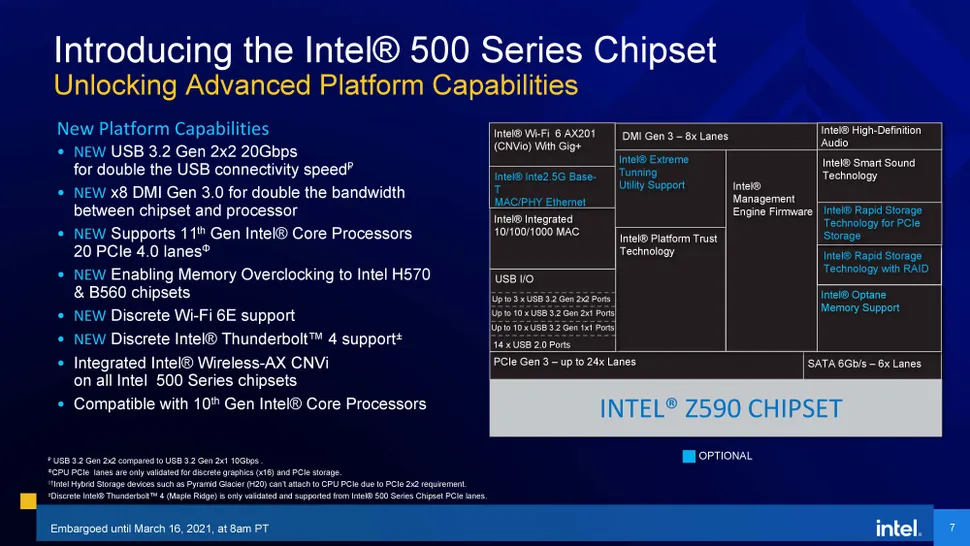
(Image credit: Intel)
Intel has spent a long five months on the ropes after AMD’s Zen 3-powered Ryzen 5000 chips beat the company’s Comet Lake processors in every metric that matters, taking an unprecedented lead in our Best CPUs and CPU Benchmark hierarchy, but now Intel is finally blasting back with its 11th Gen Rocket Lake chips. Today Intel has finally revealed the official specs and pricing for Rocket Lake in advance of the March 30th embargo date for full reviews and retail sales.
However, while much of AMD’s successful formula has consisted of more cores, a newer architecture, and a newer and denser 7nm node, Intel is launching a new architecture on its older less-efficient 14nm node, but with fewer cores and a higher price tag.
As a result, Rocket Lake’s flagship $539 Core i9-11900K comes to market with eight cores while the previous-gen Core i9 family came with 10 cores and AMD’s leading chips stretch up to 16. Surprisingly, Intel has actually hiked its recommended pricing on its highest-end chips despite this seeming deficiency, signaling that it thinks its eight-core chips have the chops to take on AMD’s competing models.
Much of Intel’s confidence stems from its first new microarchitecture for the desktop PC in the last six years, Cypress Cove. Intel says it backported its Sunny Cove design from the 10nm process to its aging 14nm to create the new design, a necessity because 10nm couldn’t support the higher frequencies needed for desktop PCs (we imagine yields might have played a role, too).
Intel admits that Rocket Lake’s lowered core count can lead to reduced gen-on-gen performance in heavily-threaded applications, but the Cypress Cove architecture brings a 19% improvement in instruction per cycle (IPC) throughput and Rocket Lake also tops out at a blistering 5.3 GHz that Intel says will help reestablish its performance leadership in gaming. Naturally, higher IPC and fast clocks help offset the step back to fewer cores, at least in most applications, but there will be areas of regression.
Rocket Lake has plenty of other notable advances, too: Intel stepped forward to faster DRAM speeds (though that comes with a big caveat), finally adopted the PCIe 4.0 interface, added AVX-512 support and AI-boosting DL Boost technology, and also moved to the integrated UHD Graphics 750 engine that hails from the company’s 10nm Tiger Lake chips. Intel says these Xe-powered graphics provide up to 50% more performance than preceding models. Intel also has its eyes on other gaming optimizations with added support for Resizable Bar, which boosts gaming performance with supported discrete GPUs, and caters to the enthusiast crowd with a host of overclocking features to wring more performance from the silicon, including unlocked memory overclocking with cheaper B- and H-series motherboards. We finally have all of the new details; let’s dive in.
Intel 11th-Gen Core Rocket Lake-S Specifications and Pricing
Intel’s chip specifications have become an incredibly confusing affair for most normal folks, with different specifications for Thermal Boost Velocity (TVB) in both single and all-core flavors, along with separate all-core boost turbo, Turbo Boost 2.0 (TB2) and Turbo Boost 3 (TB3) ratios all combining to create a stunningly complex mishmash of specs — sometimes all on a single model. To present the data in a digestible format, we’ve boiled that down to the peak frequencies listed in the table below. We’ve also culled a few of the less interesting models, at least in terms of the competitive landscape, from the table to focus on the key competitive price bands. We’ll provide the full specs and list of models later in the article.
Intel spreads the Rocket Lake (RKL-S) chips into the familiar Core i9, i7, and i5 families, but there’s a fly in the ointment: Intel has decided to use refreshed Comet Lake (CML-R) chips for its Core i3 and Pentium families. Those chips feature the same architecture as other Comet Lake chips but come with slightly increased clock speeds, which we’ll cover a bit later. Intel also continues to offer graphics-less F-series models that offer the same specs as their full-featured counterparts, but at a lower price point.
| Product Identifier | Suggested Price | Cores / Threads | Base (GHz) | Peak Boost (Dual/All Core) | TDP | iGPU | L3 |
| Ryzen 9 5950X | $799 | 16 / 32 | 3.4 | 4.9 | 105W | None | 64MB (2×32) |
| Ryzen 9 5900X | $549 | 12 / 24 | 3.7 | 4.8 | 105W | None | 64MB (2×32) |
| Ryzen 7 5800X | $449 | 8 / 16 | 3.8 | 4.7 | 105W | None | 32MB (1×32) |
| RKL-S Core i9-11900K (KF) | $539 (K) – $513 (KF) | 8 / 16 | 3.5 | 5.3 / 4.8 (TVB) | 125W | UHD Graphics 750 Xe 32EU | 16MB |
| CML-S Core i9-10900K (KF) | $488 (K) / $472 (KF) | 10 / 20 | 3.7 | 5.3 / 4.8 (TVB) | 125W | UHD Graphics 630 | 20MB |
| CML-S Core i9-10850K | $453 | 10 / 20 | 3.6 | 5.2 / 4.8 (TVB) | 125W | UHD Graphics 630 | 20MB |
| RKL-S Core i9-11900 (F) | $439 – $422 (F) | 8 / 16 | 2.5 | 5.2 (TVB) / 4.7 | 65W | UHD Graphics 750 Xe 32EU | 16MB |
| RKL-S Core i7-11700K (KF) | $399 (K) – $374 (KF) | 8 / 16 | 3.6 | 5.0 (TB3) / 4.6 | 125W | UHD Graphics 750 Xe 32EU | 16MB |
| CML-S Core i7-10700K (KF) | $374 (K) / $349 (KF) | 8 / 16 | 3.8 | 5.1 (TB3) / 4.7 | 125W | UHD Graphics 630 | 16 MB |
| RKL-S Core i7-11700 (F) | $323 -$298 (F) | 8 / 16 | 2.5 | 4.9 (TB3) / 4.4 | 65W | UHD Graphics 750 Xe 32EU | 16MB |
| Ryzen 5 5600X | $299 | 6 / 12 | 3.7 | 4.6 | 65W | None | 32MB (1×32) |
| RKL-S Core i5-11600K (KF) | $262 (K) – $237(KF) | 6 / 12 | 3.9 | 4.9 (TB2) / 4.6 | 125W | UHD Graphics 750 Xe 32EU | 12MB |
| CML-S Core i5-10600K (KF) | $262 (K) / $237 (KF) | 6 / 12 | 4.1 | 4.8 (TB2) / 4.5 | 125W | UHD Graphics 630 | 12MB |
| RKL-S Core i5-11400 (F) | $182 – $157 | 6 / 12 | 2.6 | 4.4 (TB2) / 4.2 | 65W | UHD Graphics 750 Xe 24EU | 12MB |
It’s clear that Intel has ceded the high core-count portion of the mainstream desktop PC to AMD, with its core counts now topping out at eight compared to AMD’s peak of 16 cores with the Ryzen 9 5950X. Intel has chosen to fight at or below the $539 price point with Rocket Lake, but Alder Lake will come later this year with a core-heavy hybrid architecture to compete with AMD’s highest-end parts.
The eight-core 16-thread flagship Core i9-11900K comes with a suggested $539 price tag, a $51 markup over the previous-gen ten-core 10900K, but you pay the premium for two fewer cores. The 11900K is also more expensive than the $449 Ryzen 9 5800X. Even more concerning, the ten-core Core i9-10850K, which has nearly identical performance to the 10900K, weighs in at a mere $453, opening up a much larger $86 gap. Intel’s performance benchmarks, which we’ll get to shortly, tout faster gen-on-gen gaming performance, but the value proposition looks dicey. Of course, our own benchmarks will tell the tale.
Two of the 11900K’s cores boost to a peak of 5.3 GHz, and all cores can operate at 4.8 GHz simultaneously. These are Thermal Velocity Boost frequencies that only activate if the processor is under a certain temperature limit, but most motherboard makers ignore those limits. That means the chips will likely operate at these speeds regardless of chip temperature, at least on higher-end motherboards. Intel has listed a 150W PL1 power rating (at the base frequency) for the 11900K, a 25W increase over the 10900K, but it has an identical 250W PL2 (boost) rating.
Here’s where things get tricky: The Core i9-11900K is the only Rocket Lake chip that supports DDR4-3200 memory in the optimal configuration at stock settings, which is called ‘Gear 1.’ This setting allows the memory controller and memory frequency to operate at the same speed (1:1), thus providing the lowest latency and best performance in lightly-threaded work, like gaming.
All other Rocket Lake chips only officially support DDR4-3200 with the ‘Gear 2″ setting, which downshifts the memory controller so that it operates at half the frequency of the memory (0.5:1). This setting trades higher memory latency (i.e., reduced performance in single-threaded work) for improved bandwidth, which can benefit a narrow selection of threaded workloads.
For all other SKUs, the official top speed for the Gear 1 setting is DDR4-2933, and running DDR4-3200 in lower-latency Gear 1 mode is considered overclocking, which voids your warranty. Intel isn’t sharing latency information to detail the differences between the two modes and how that impacts performance, so we’ll have to suss that out in our review.

In either case, this is a very confusing practice for an average consumer to understand and adds yet another level of complexity to Intel’s product stack. Intel justifies this approach because the memory controllers fall into the binning equation, meaning chips with slower memory controllers are only rated for DDR4-3200 in Gear 2 mode.
This brings us to the $399 Core i7-11700K that slots into the big pricing gap between the $299 Ryzen 5 5600X and $449 Ryzen 7 5800X. As we can see, core counts are no longer the delineating feature between the Core i9 and Core i7 families — instead, we’re left with a few bins of frequency and the differences in Gear modes. Like the 11900K, the 11700K chip comes with eight cores and 16 threads, but it doesn’t have Thermal Velocity Boost. As such, the 11700K tops out 5 GHz on two cores via TB3 tech, and all cores can stretch up to 4.6 GHz simultaneously.
The gen-on-gen price increase for the 11700K is lower, but still present. At $399, Intel commands a $25 premium over the previous-gen 10700K that comes with the same number of cores and slightly higher boost frequencies. Naturally, Rocket’s improved IPC should come into play to bring about better performance than its predecessor, but again, we’ll have to see how testing plays out to decide whether it’s worth the upcharge.
Intel’s non-K Core i9 and i7 models carry the same pricing as their prior-gen counterparts, and pricing is also normalized with the $262 six-core Core i5-11600K, which matches the pricing of the previous-gen i5-10600K. This chip boosts to a peak of 4.9 GHz on two cores and can maintain a 4.6 GHz all-core frequency. The Core i5-11600K is a key model for Intel, as it contends directly with the $299 Ryzen 5 5600X in the heart of the mainstream gaming market.
The Core i5-11400 also stands out as a potentially great deal, with $182 (or $157 for the F-series part) being a solid price for a six-core 12-thread processor.
Intel 11th-Gen Core Rocket Lake Gaming Benchmarks
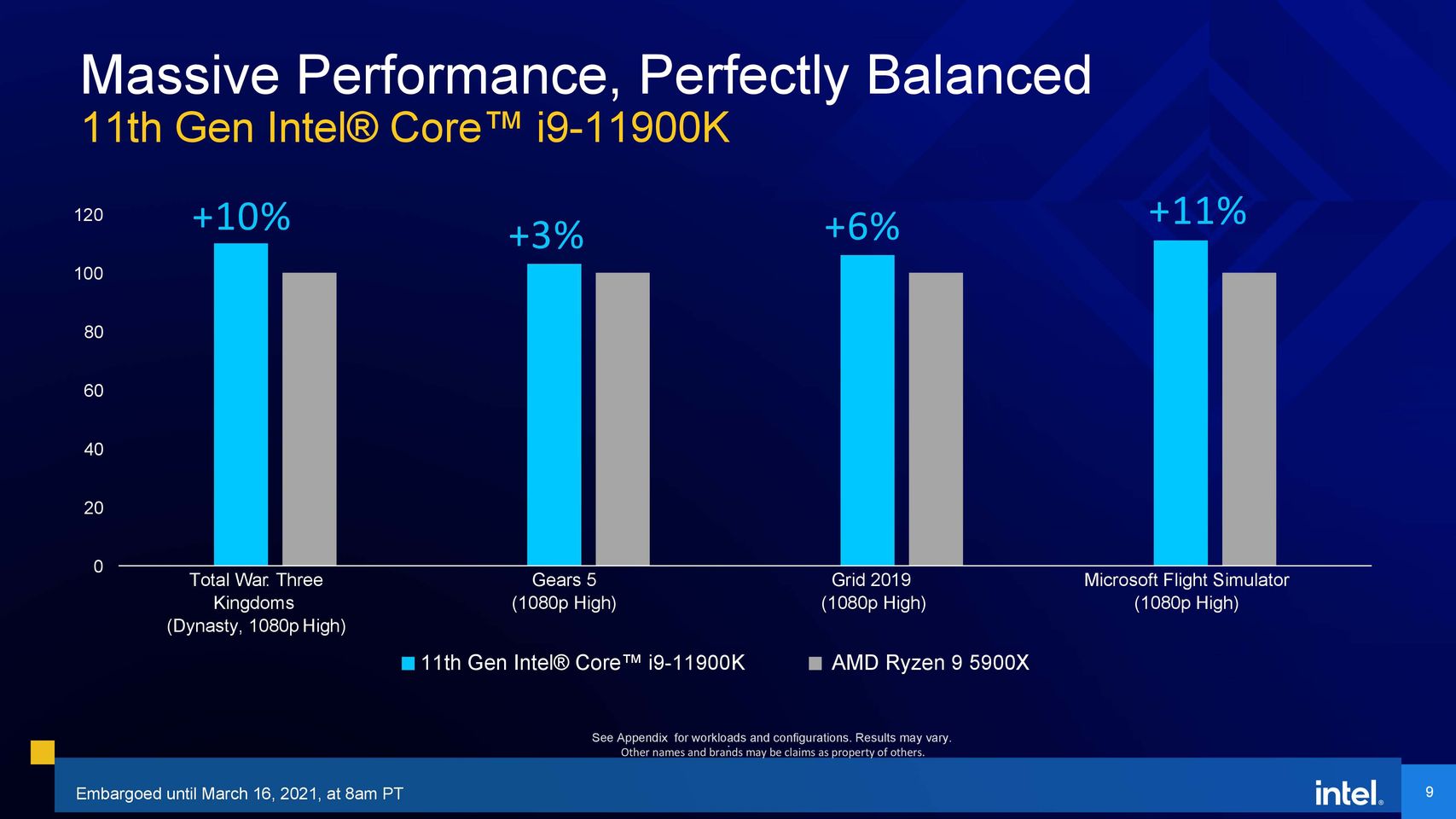
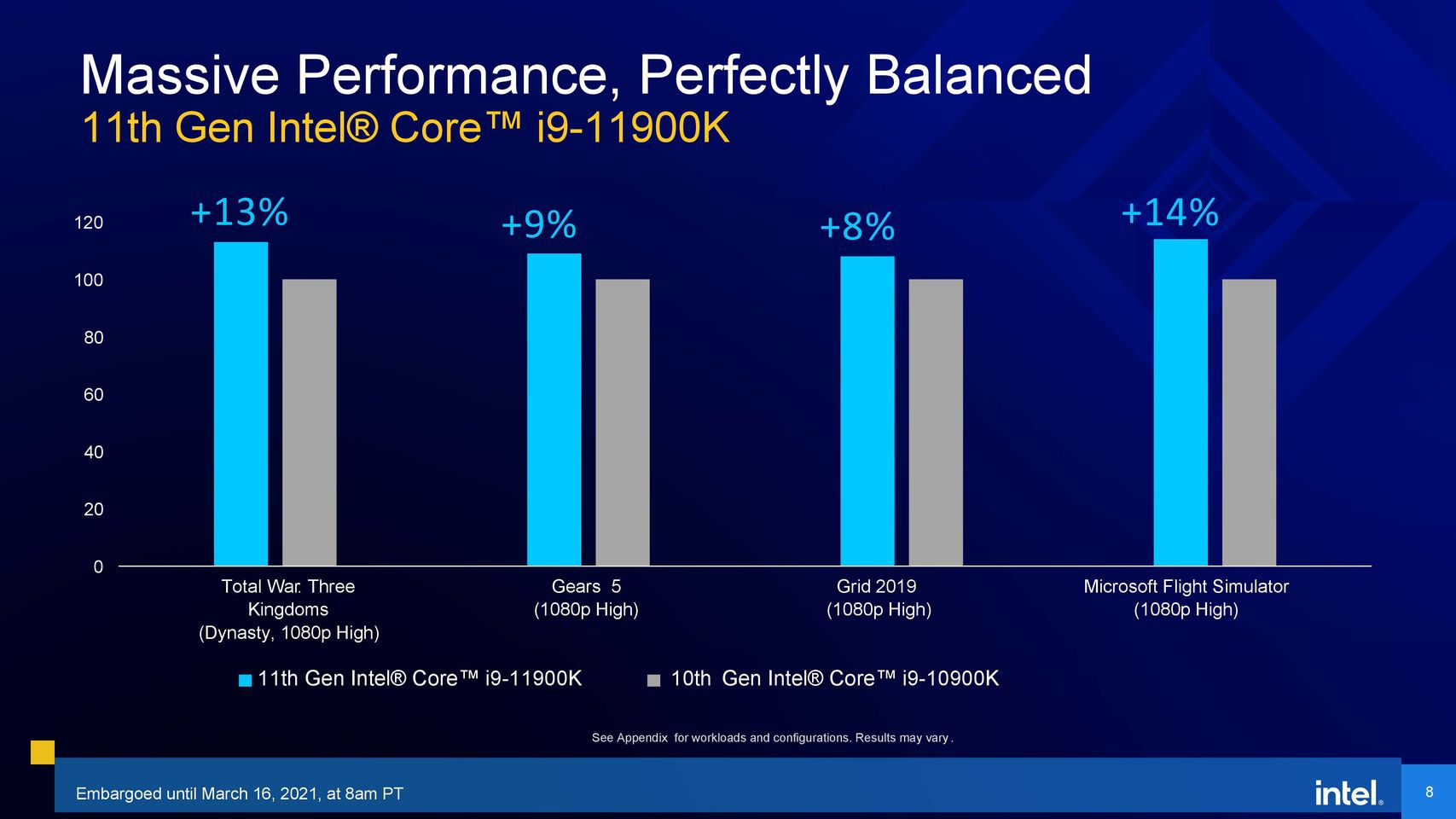
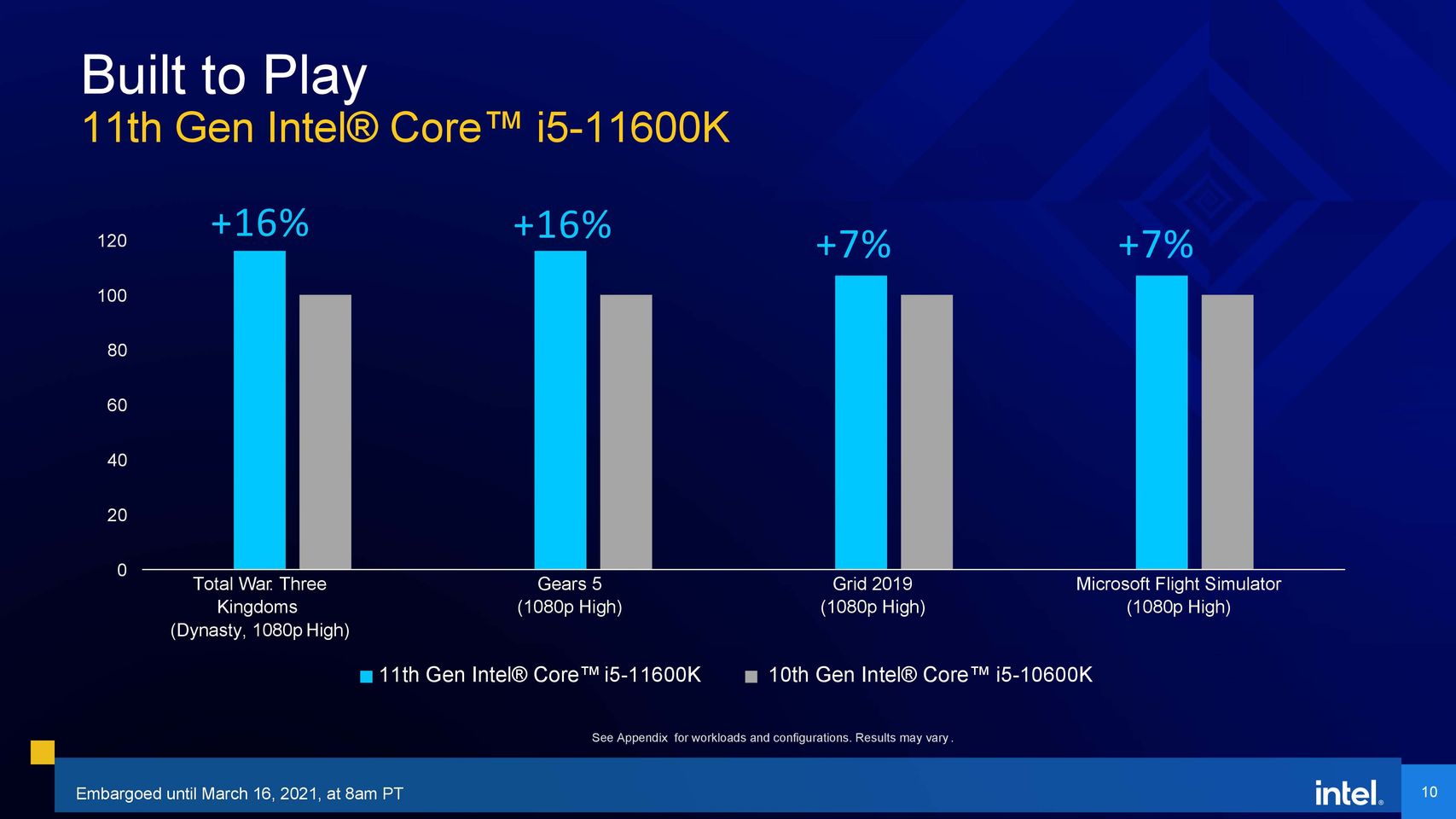
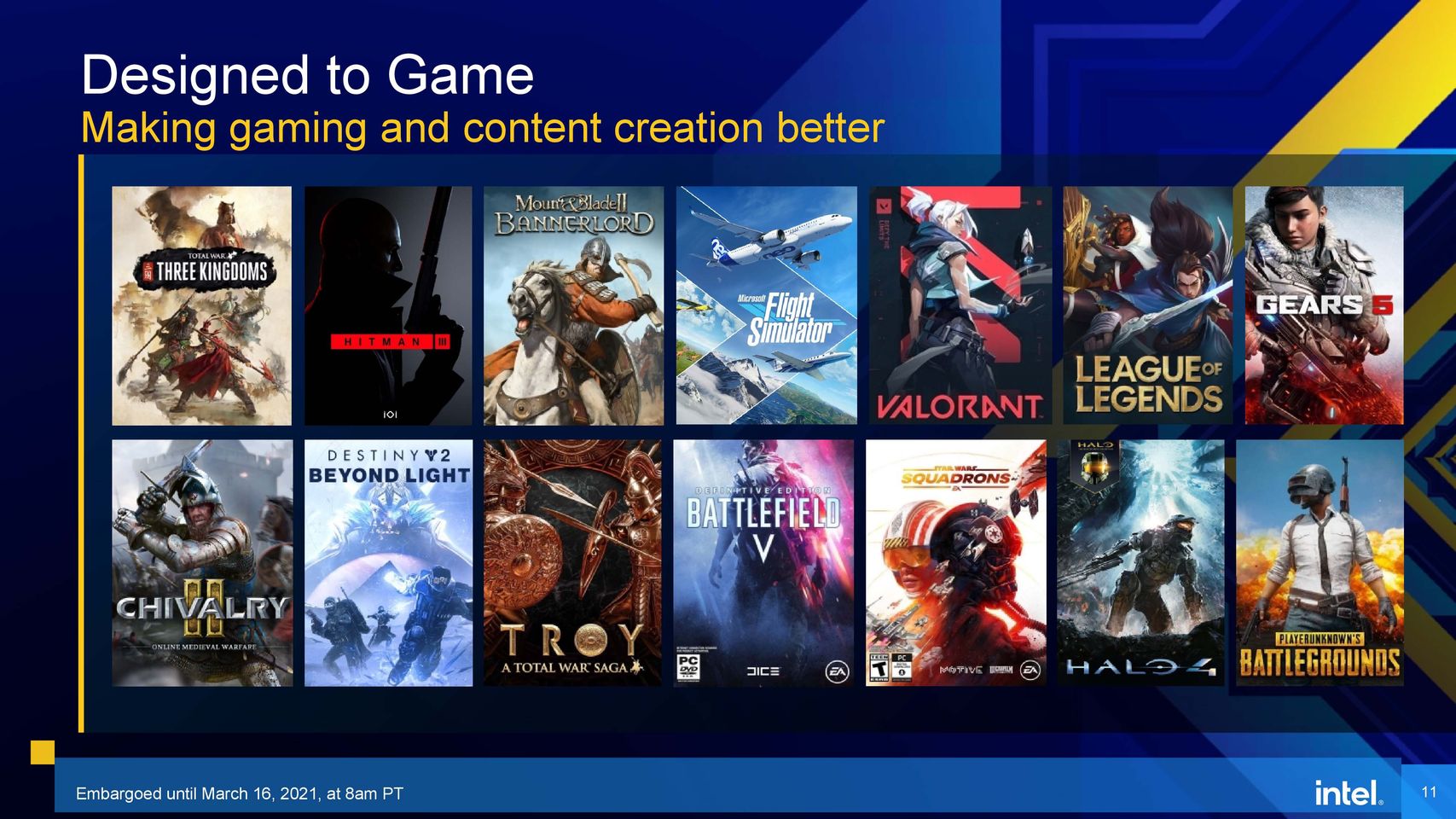
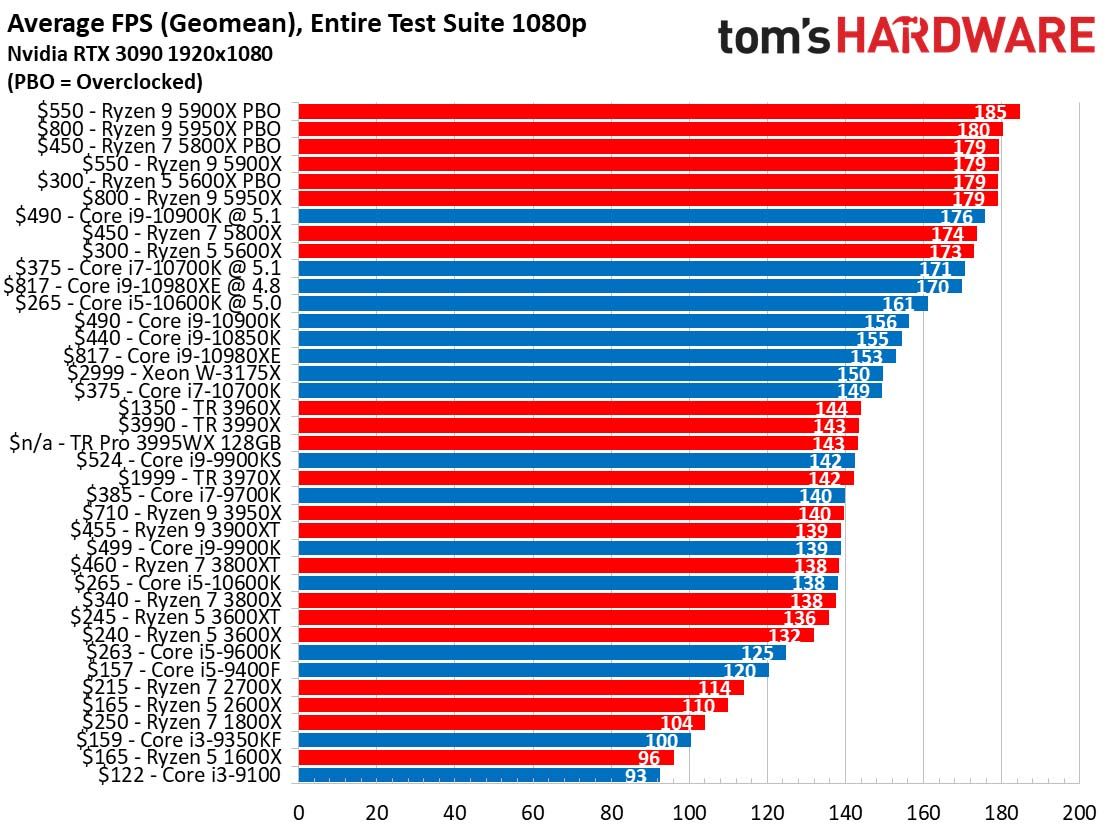
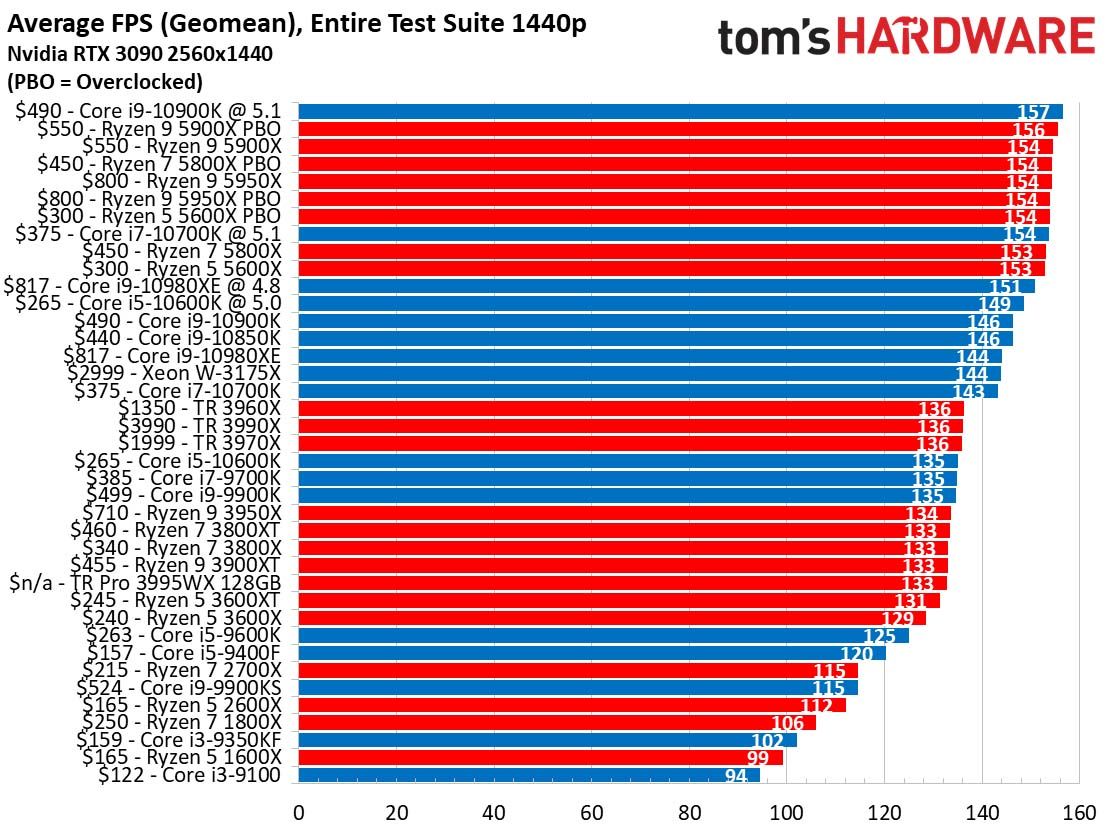
Intel provided a few benchmarks to underline its gaming leadership claims, but due to some disparities we noted with the test setups, you’ll need to take these with a heaping spoonful of salt.
Intel listed the PL1 rating, which is the power consumption measured at base frequencies, as 250W for all Rocket Lake processors in its gaming tests. This represents a 100W increase over Intel’s 150W PL1 spec (250W is the PL2 rating -power during boost), which serves as a form of cheaper-yet-sanctioned overclocking. Intel also didn’t specify the Tau (boost duration) used for the tests (we suspect it is unlimited), making these results suspect.
Meanwhile, the company assigned the competing Ryzen processor at its standard 105W PL1 and the Comet Lake models to a 150W PL1, meaning we’re looking at a lopsided battle where the newer Intel processor is free to draw more than twice the power with essentially an unlimited boost duration. We’ve included the test notes with Intel’s detailed configurations at the end of the article.
Intel outfitted all test systems with 32GB of memory set to the maximum supported speeds and with tight timings (14-14-14-34), an EVGA RTX 3080 XC3 Ultra, and an unspecified watercooler.
Intel compared the Core i9-11900K to the Ryzen 9 5900X, which currently tops our CPU benchmarks as the fastest gaming chip on the market, in a narrow selection of titles at 1080p High settings. Intel claims a 10% advantage over the Ryzen 9 5900X in the Total War Kingdoms Dynasty benchmark, 9% higher fps in Gears 5, an 8% advantage in GRID 2019, and an 11% lead in Microsoft Flight Simulator 2020.
Intel also presented gaming benchmarks showing the gen-on-gen performance gains of the Core i9-11900K against the 10900K, and the Core i5-11600K against the 10600K. As you would imagine, Intel recorded strong generational gains. However, while the Rocket Lake processors were apparently dialed into a 250W PL1, the Comet Lake chips are listed at their default 125W PL1 rating, meaning these results are likely skewed, too.
Intel’s final slide plays up its strong partnerships with several game developers, through which it helps optimize their game engines for Intel processors. Bear in mind that three of the four titles used for Intel’s gaming benchmarks are listed. For a perspective of the current state of gaming performance, we included a few of our own gaming benchmarks at the end of the album with the current Comet Lake and Ryzen lineups.
Intel 11th-Gen Core Rocket Lake Application Benchmarks
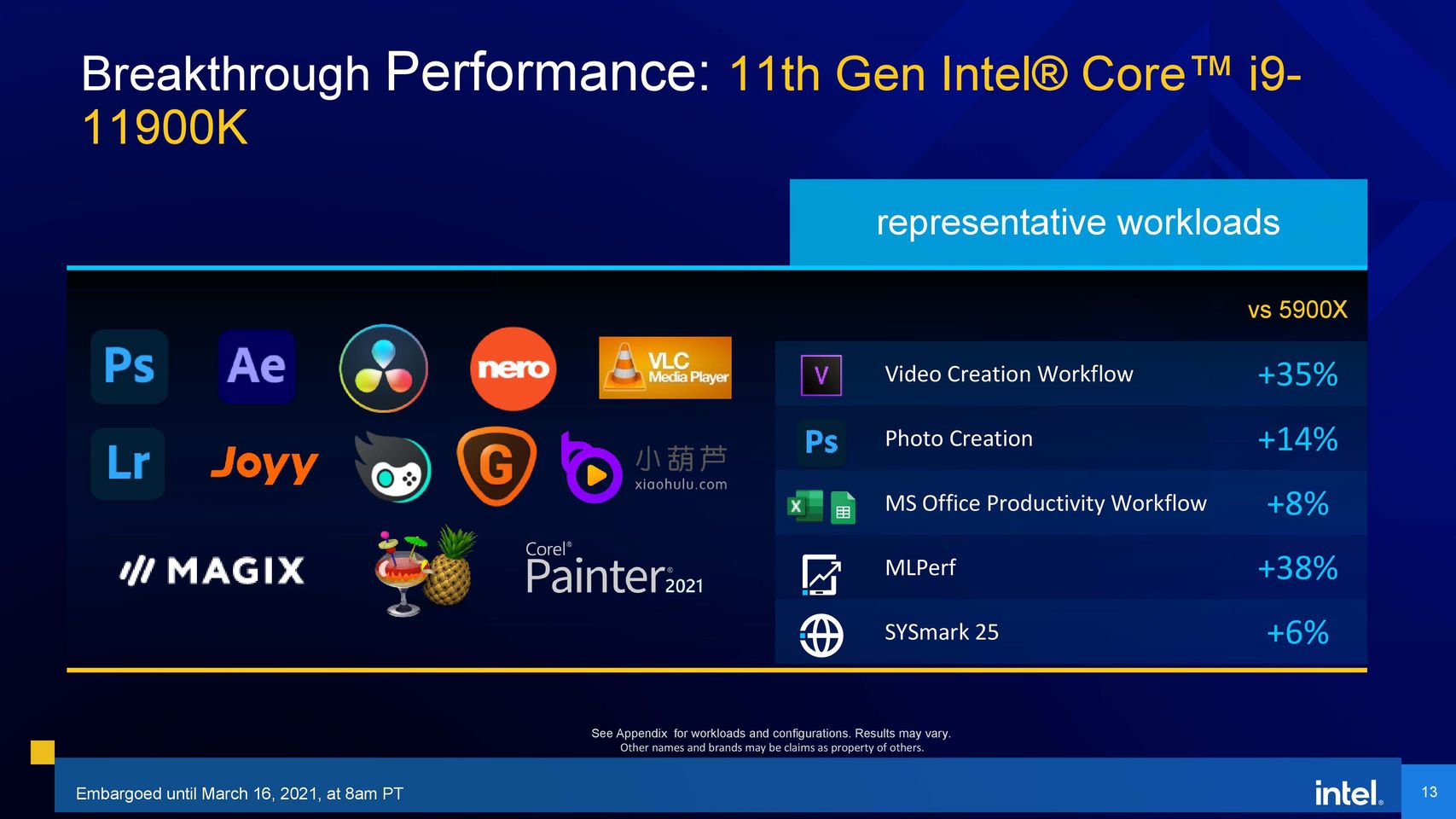
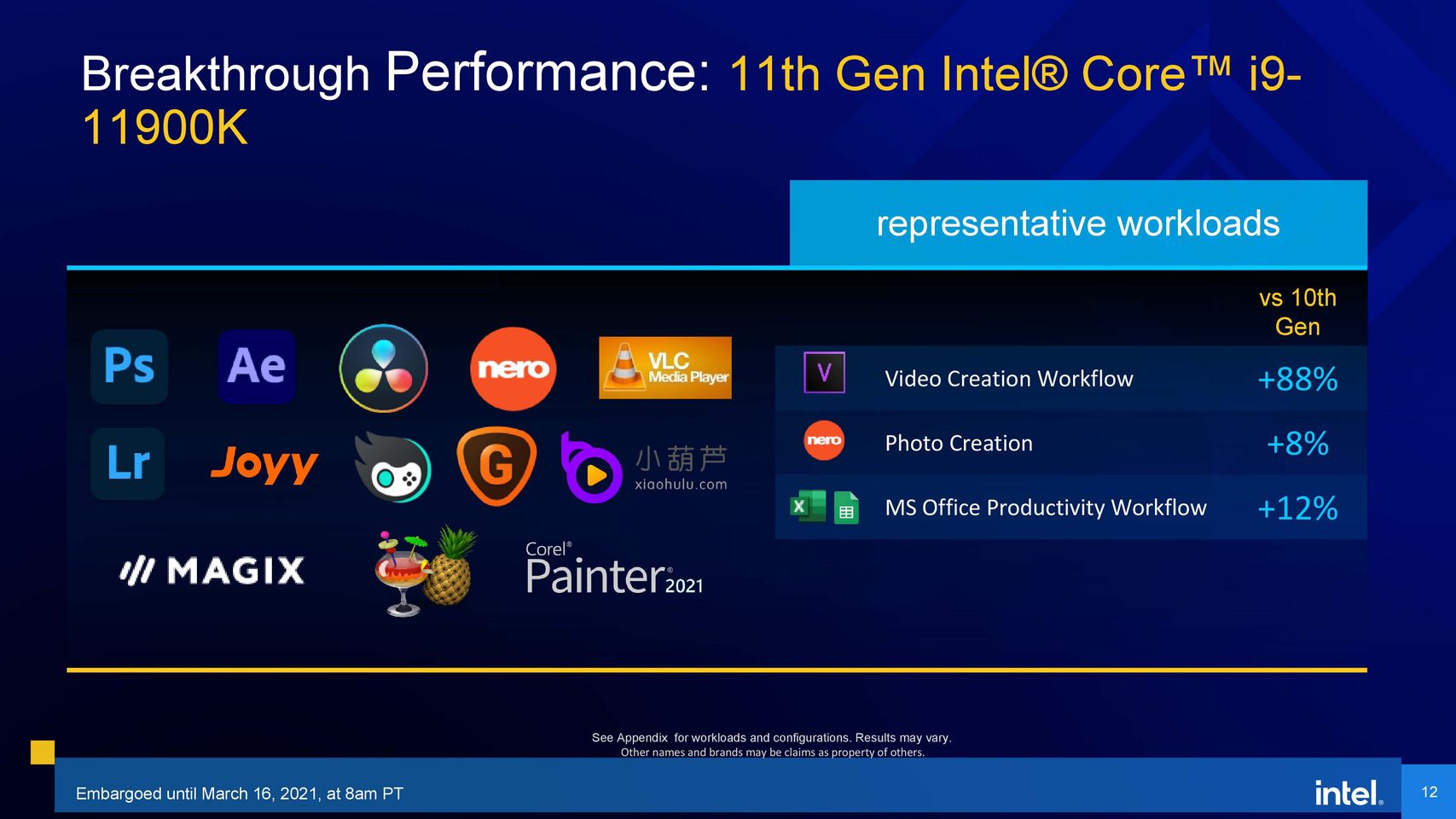
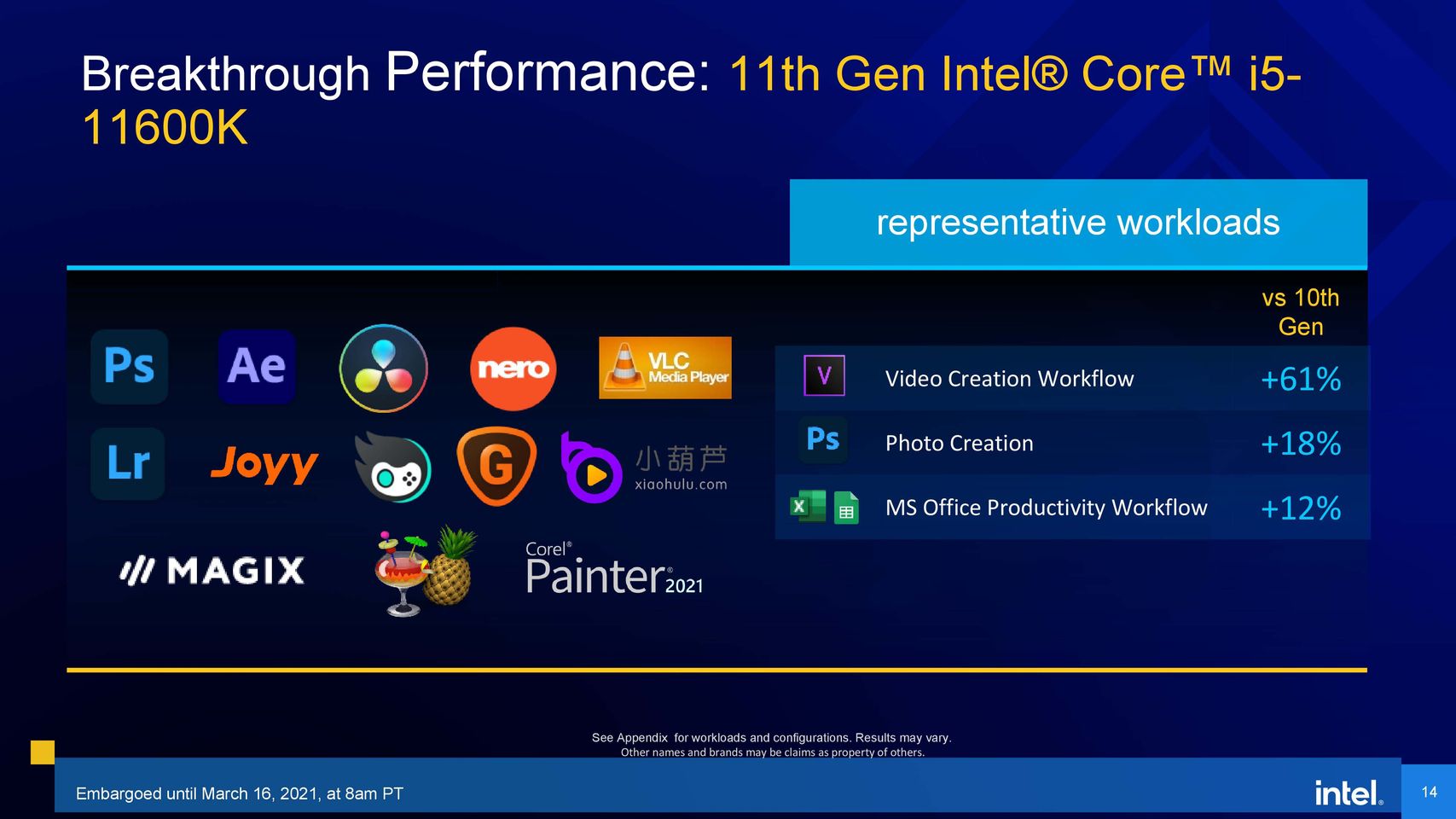
Intel also presented several benchmarks in productivity applications, but with a heavy focus on software that uses AI inference through targeted code optimizations that leverage Rocket Lake’s hardware-accelerated DL Boost and VNNi technology. As such, the Rocket Lake chips naturally have an easy advantage over competing chips that don’t support the technology.
Again, Intel provided benchmarks to show its own generational performance gains, and also to measure performance relative to the Ryzen 9 5900X. The Photoshop Photo Creation benchmark runs a colorizing workload on seven images and leverages Intel’s inference tech, while the Magix Vegas Pro video creation workflow utilizes DL Boost and OpenVINO, with both granting large performance gains over processors without hardware-accelerated AI features. MLPerf is also a perfect test to highlight hardware-accelerated advantages over competing chips.
Likewise, Nero’s photo tagger feature also leverages Intel’s DL Boost, but curiously, Intel only used it for comparisons to its own previous-gen models, and not the Ryzen 9 5900X.
These benchmarks do highlight impressive gains in a few applications that are optimized to exploit the advantages of Intel’s hardware-accelerated AI suite, but many of these programs only use inference for a subset of their overall capabilities, and industry uptake will take some time to expand out to other types of software.
We can’t say that these tests are indicative of the typical performance you can expect in most content creation and productivity applications, and Intel’s reluctance to share results in a broader spate of typical workloads isn’t very encouraging.
Intel’s Rocket Lake Die Shots and Comparisons
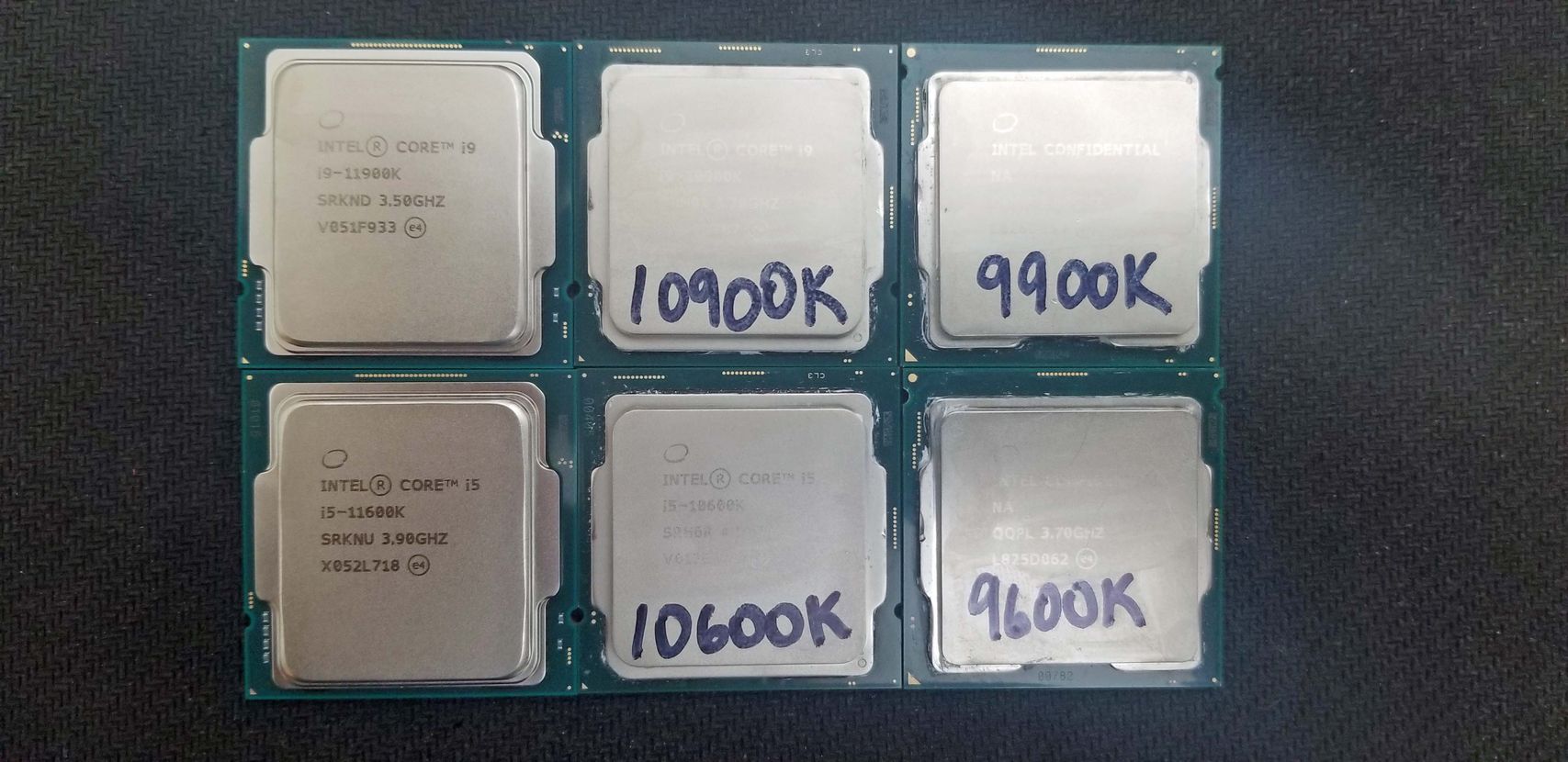
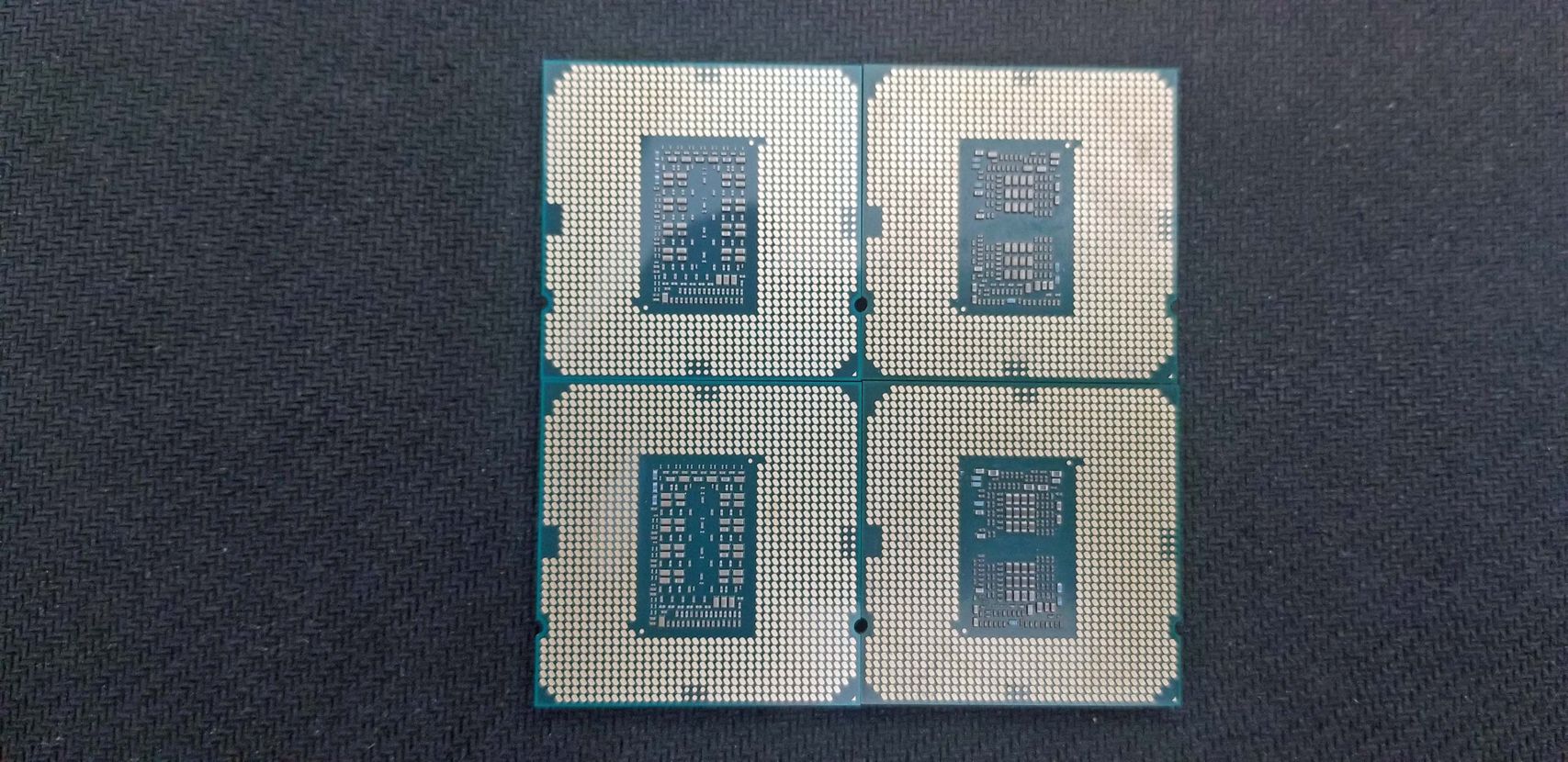
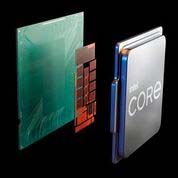
Here we can see our Core i9-11900K and Core i5-11600K samples next to two prior generations of the same series. The integrated heat spreader (IHS) and PCBs appear largely identical from the top, though the 9th-Gen processors have slightly slimmer ‘ears’ flanking the IHS for the socket retention mechanism to clamp down on. A closer look reveals that Intel has reduced the height of the IHS for the Rocket Lake chips by roughly 0.5mm, probably due to further die thinning or to reduce the amount of solder between the die and IHS, thus improving thermal dissipation.
This adjustment comes as a byproduct of Intel’s increased power consumption with each new generation of 14nm chips, which necessitates more aggressive techniques to dissipate thermal load. Intel had already reduced the thickness of the PCB with the 8th-gen models, leaving little room for additional thinning of the PCB, and then turned to thinning the die for the 10th-gen Comet Lake chips to help improve cooling. Rocket Lake’s addition of AVX-512 support, which trades higher power consumption for more efficiency, obviously exacerbates cooling issues.
Flipping the chips over reveals the same LGA pad arrangement for both Comet Lake and Rocket Lake, which is expected given that they drop into the same LGA1200 socket. We also notice a different arrangement of surface mount devices (SMD) in the center of the chips.

We aren’t prepared to potentially sacrifice our sample by doing a risky delid yet, but luckily a daring enthusiast recently delidded an Core i7-11700K processor and shared the results at the Overlock.net forums. Unfortunately the processor didn’t live through the procedure, but we can get a good sense of the size of Rocket Lake’s die through a photo lineup compiled from Der8auer’s excellent die analysis article (via @harukaze5719).
Intel has confirmed that all Rocket Lake-S chips come with the same eight-core die, with two cores disabled for the six-core models. Surprisingly, based on our rough projections, Rocket Lake’s eight-core die is about 34% larger than the ten-core Comet Lake die.
| Generation | Model | Cores | Die Size |
| Rocket Lake-S | Core i7-11700K | Eight | 276.4 mm2 |
| Comet Lake-S | Core i9-10900K | Ten | 206.1 mm2 |
| Coffee Lake-S Refresh | Core i9-9900K | Eight | 180.3 mm2 |
| Coffee Lake-S | Core i7-8700K | Six | 153.6 mm2 |
Intel chalks much of this disparity up to GPU and CPU cores that are physically larger than those found on Comet Lake, a byproduct of backporting from 10nm to 14nm, along with the increased number of graphics EUs. Intel could have shrunk or removed the integrated graphics engine to cram in more CPU cores to meet its power, performance, area, and cost (PPAC) targets, but integrated graphics are a key requirement for the high-volume OEM systems market that tends to leverage on-chip graphics rather than discrete GPUs.
Intel’s 14nm process is ultra-mature, so we assume yields are well in line and the majority of its chipmaking equipment is depreciated. However, fabbing a larger die exposes the chips to a greater chance of defects, thus complicating the binning process, and also results in fewer die per wafer. All of these factors increase cost, which could help explain Intel’s higher pricing for its highest-binned SKUs.
Intel 11th-Gen Core Rocket Lake Overclocking
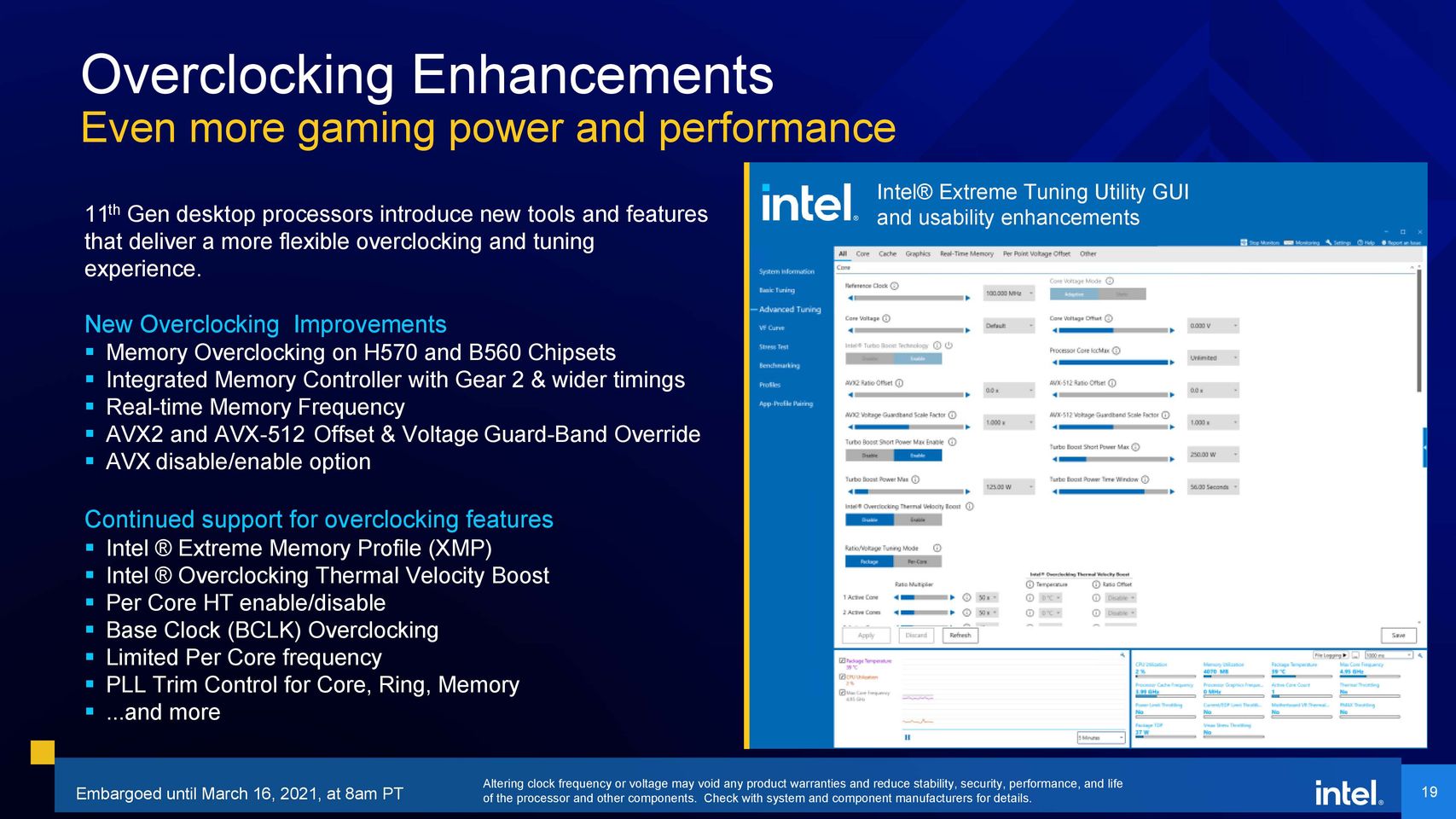
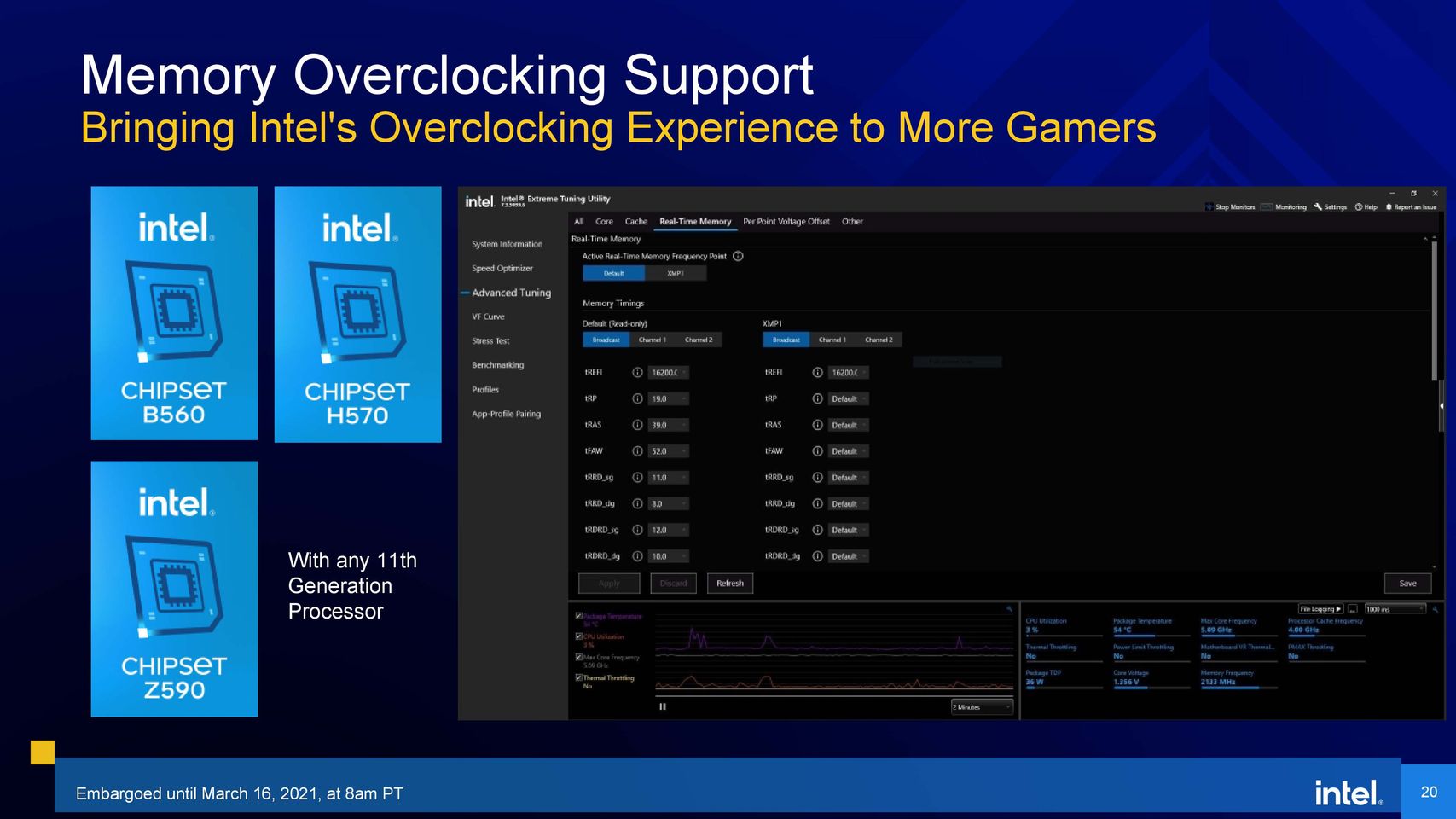
Intel recently discontinued its Performance Tuning Protection Plan (PTPP), an extended warranty plan that offered protection from damage that occurred during overclocking. That led to plenty of commentaries that overclocking is dying, but Intel says differently and has increased its overclocking capabilities, like adding support for memory overclocking on lower-end 500-series B- and H- chipsets.
Intel has also revamped its eXtreme Tuning Utility (XTU) with a new, fresher look and added new features to enable Rocket Lake’s new overclocking options. That includes new overclocking offsets, like a separate AVX-512 offset and the ability to set voltage guardbands for the different flavors of AVX. Intel also added an option to completely disable AVX support, though that feature is primarily geared for professional overclockers.
Dan Ragland, Intel’s principle overclocking engineer, says that most users can expect similar overclocked CPU frequencies to the 10th-Gen Comet Lake processors. That equates to a common ceiling of a 5.2 GHz all-core overclock (with AVX offsets applied) on most Rocket Lake chips, though the silicon lottery does apply. With more robust cooling, Ragland claims users with cherry chips can add a few more hundred megahertz to that total, albeit on a limited number of cores.
Although Rocket’s overclocking ceilings are very similar to Comet Lake, the increased IPC should result in larger performance gains, comparatively. Like the Comet Lake chips, Rocket also supports per-core frequency and hyper-threading control (enable/disable) to help eke out more overclocking headroom.
Intel also offers revamped memory overclocking features, like the Gear 1 and Gear 2 modes we covered earlier. Aside from being used as a somewhat questionable tactic to segment Intel’s product stack, these settings also allow overclockers to reach higher memory frequencies.
Intel has also added support for real-time memory frequency adjustments, though motherboard support will vary by model and vendor. This feature allows you to shift from, say, DDR4-2933, for example, to DDR4-3200 from within Windows 10 without rebooting. Intel also continues to support its existing mechanism for live memory timing adjustments from within the operating system, giving users a plethora of on-the-fly memory overclocking options. Overall, Ragland says he thinks that Rocket Lake’s memory controllers, which are entirely new, coupled with the expanded memory overclocking features, will help topple many of the existing world records.
Intel’s overclocking headroom, while shrinking, still tends to be a big advantage over AMD’s chips. Intel also helped develop new sub-ambient coolers from EKWB QuantumX Delta TEC and Cooler Master MasterLiquid ML360 Sub-Zero to bring extreme cooling to the masses, but these are somewhat expensive and exotic solutions for very specific uses, which you can read about here
Intel 11th-Gen Core Rocket Lake Xe Graphics
Most Rocket Lake chips come with the UHD Graphics 750 engine powered by 32 EUs with the Xe architecture. Intel has carved the Xe LP graphics engine into UHD Graphics 750 (GT1) with 32 EUs and UHD Graphics 730 (GT1) with 24 EUs. The latter makes an appearance on the Core i5-11400 (T and F) chips. Intel also added new features to the graphics engine, with HEVC, VP9, and SCC encoders that support up to 4K60 12b and hardware-accelerated AV1 encode support for 4K60 10b.
Intel dedicated more die area to the graphics engine than it did with Comet Lake, noting that not only has it increased the number of EUs from 24 to 32, but the EUs are also physically larger than prior 14nm EUs. The increased iGPU real estate was a factor in Rocket’s limitation of eight CPU cores.
Intel bases its 50% generational iGPU performance improvement claim on the 3DMark Firestrike GPU benchmark, and as with all synthetic gaming tests, those results don’t often translate well to real-world gaming. As such, you should take those predictions with a grain of salt.
As before, you’re free to overclock the graphics engine and it also benefits from increased memory bandwidth, so memory overclocking pays dividends.
500-Series Chipset and Rocket Lake Compatibility
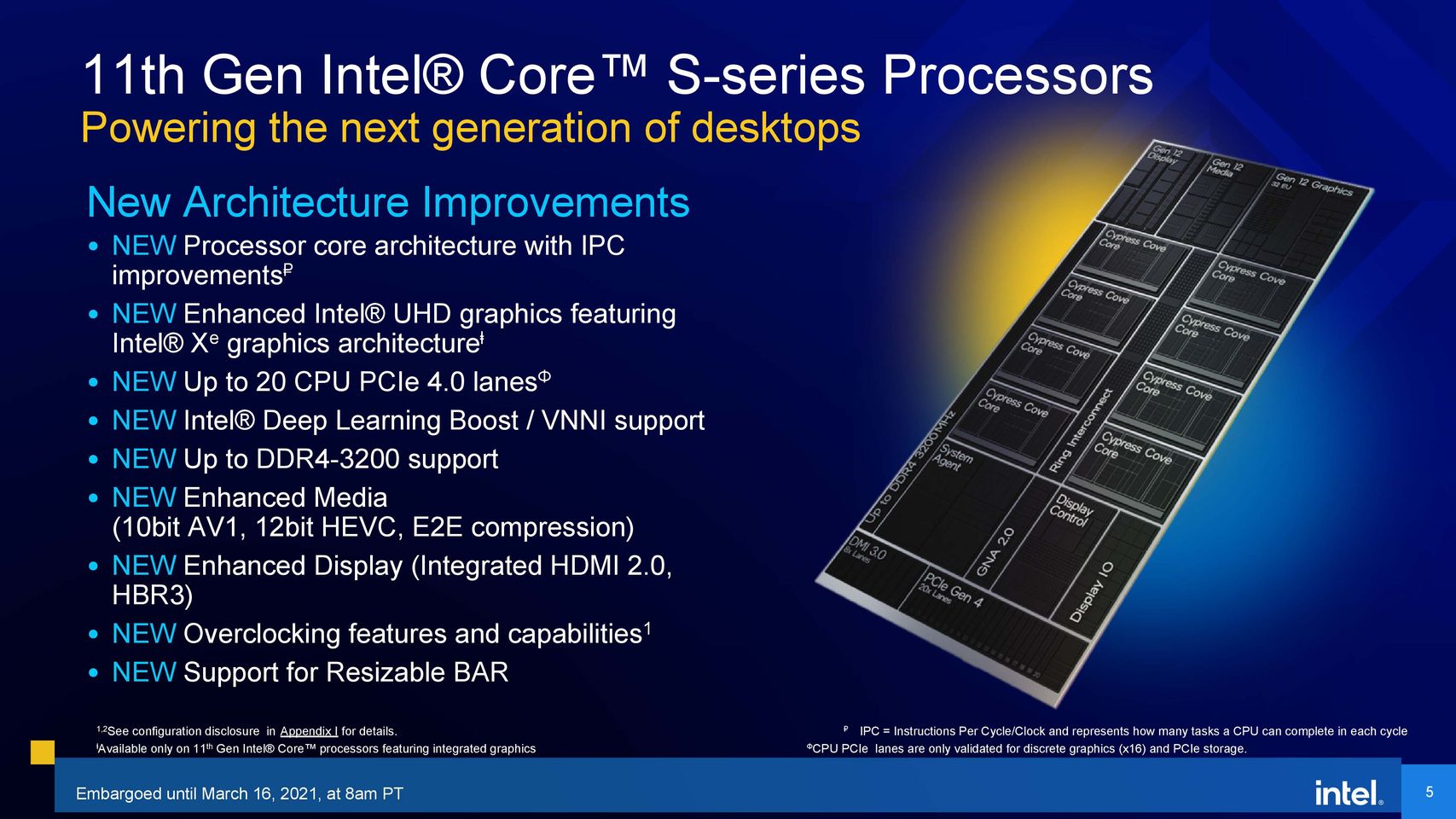
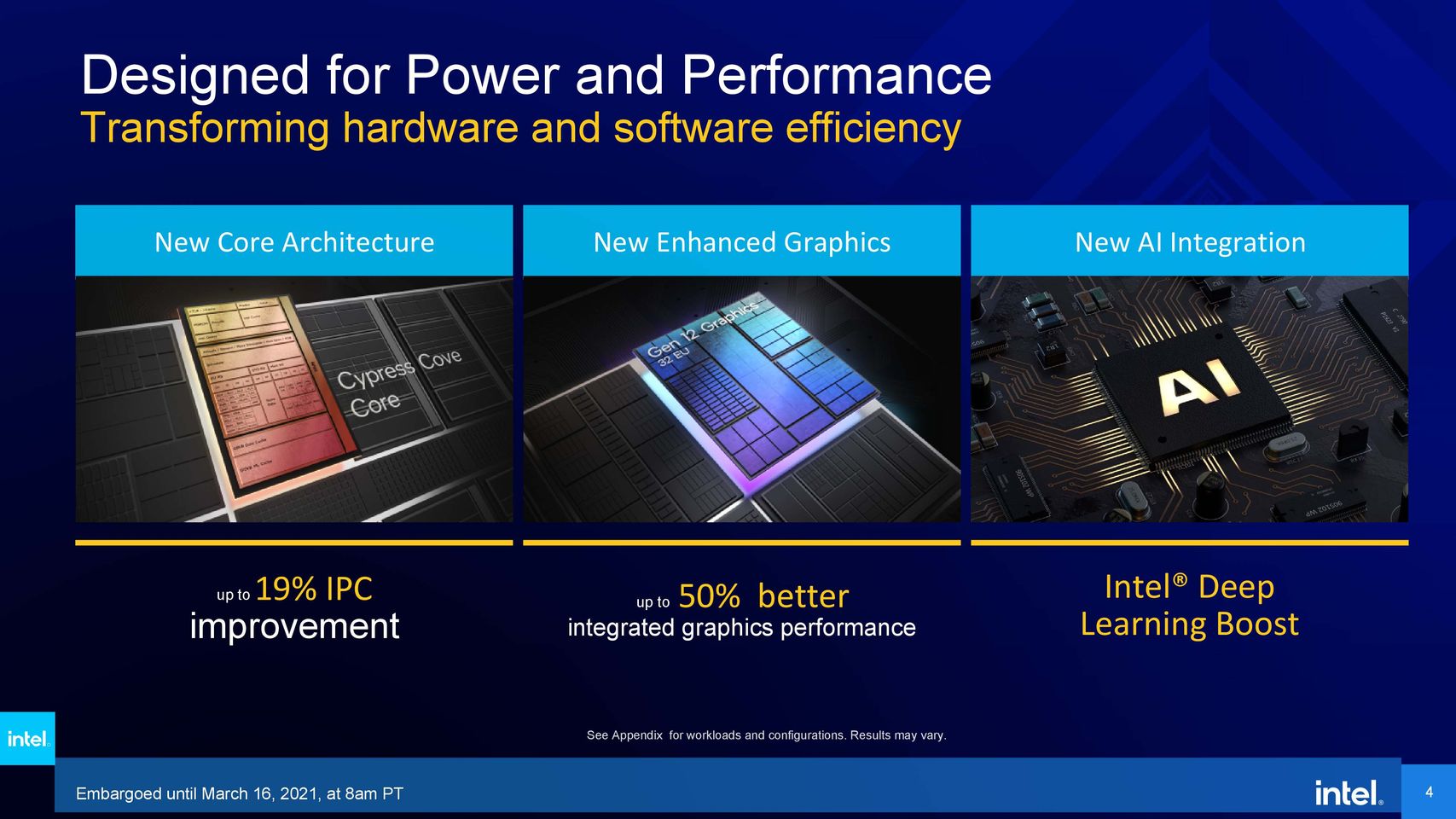
Most Rocket Lake chips come with the UHD Graphics 750 engine powered by 32 EUs with the Xe architecture. Intel has carved the Xe LP graphics engine into UHD Graphics 750 (GT1) with 32 EUs and UHD Graphics 730 (GT1) with 24 EUs. The latter makes an appearance on the Core i5-11400 (T and F) chips. Intel also added new features to the graphics engine, with HEVC, VP9, and SCC encoders that support up to 4K60 12b and hardware-accelerated AV1 encode support for 4K60 10b.
Intel dedicated more die area to the graphics engine than it did with Comet Lake, noting that not only has it increased the number of EUs from 24 to 32, but the EUs are also physically larger than prior 14nm EUs. The increased iGPU real estate was a factor in Rocket’s limitation of eight CPU cores.
Intel bases its 50% generational iGPU performance improvement claim on the 3DMark Firestrike GPU benchmark, and as with all synthetic gaming tests, those results don’t often translate well to real-world gaming. As such, you should take those predictions with a grain of salt.
As before, you’re free to overclock the graphics engine and it also benefits from increased memory bandwidth, so memory overclocking pays dividends.
500-Series Chipset and Rocket Lake Compatibility
Intel has now enabled memory overclocking on its B560 and H570 chipsets, and that will work with any chip that is compatible with the platform, meaning all 10th-Gen Comet Lake, 11th-Gen Rocket Lake, and 11th-Gen Comet Lake Refresh processors.
Intel is also adding support for Resizable Bar on all 500-series chipsets, provided the discrete GPU has a driver that supports the feature. Resizeable Bar enables faster gaming performance in some game titles by allowing the CPU to access the GPUs full frame buffer across the PCIe interface.
Rocket Lake marks Intel’s first desktop PC chips that support the PCIe 4.0 interface, a needed addition that comes two long years after AMD led the industry with the first PC chips to support the interface. Intel also reworked Rocket’s internal PCIe subsystem to accommodate a direct x4 connection for M.2 SSDs and a x16 graphics connection to the CPU (the chips now support 20 lanes of PCIe 4.0).
The Rocket Lake motherboard support matrix is complicated, though. Rocket Lake-S chips are backward compatible with Z470 and H470 chipsets, and PCIe 4.0 will work on motherboards that support the interface. However, Rocket Lake-S isn’t compatible with H410 and B460 chipsets because they use a 22nm chipset that doesn’t fully support the processors.
Intel also widened the DMI 3.0 connection (the pathway that connects the CPU and chipset) from four lanes to eight, doubling throughput up to a theoretical ~7.86 GB/s. Despite the fact that Intel widened the DMI bus, it still operates at speeds similar to PCIe 3.0. Additionally, the 500-series chipset only supports 24 lanes of PCIe 3.0 connectivity — not PCIe 4.0. Intel says this is because it had PCIe 4.0 IP ready for its chip, but not for the chipset.
In either case, the wider DMI connection should help with bottlenecks for devices attached to the chipset, like SSDs in RAID. Again, caveats apply. Rocket Lake’s wider x8 DMI connection is also only active on ‘select’ 500-series chipsets, so the chip defaults to a x4 connection on B560 and H510 motherboards. The same x4 connection DMI restriction applies if you use a Rocket Lake processor in a 400-series motherboard.
Most Comet Lake chips are forward-compatible with the new 500-series motherboards that debuted recently, the lone exception being Celeron models with 2MB of CPU cache. There are a few restrictions, though: Comet Lake chips also only use a x4 DMI connection on all 500-series motherboards.
Meanwhile, the Comet Lake Refresh models are backward compatible with all 400-series motherboards, making for a complicated support matrix. We have a deeper dive into the chipset and coverage of all forty-five Z590 motherboards for Rocket Lake and Comet Lake processors here. You can also follow this link to see the differences between Intel’s Z590, H570, B560, and H510 chipsets.
Intel Comet Lake Refresh Specifications and Pricing
| Price | Cores / Threads | Base | Boost (Single/All Core TB2) | TDP | iGPU | L3 | |
| CML-R Core i3-10325 | $154 | 4 / 8 | 3.9 | 4.7 / 4.5 | 65W | UHD Graphics 630 | 8MB |
| CML Core i3-10100 | $154 | 4 / 8 | 3.8 | 4.6 / ? | 65W | UHD Graphics 630 | 8MB |
| Ryzen 5 3400G | $150 | 4 / 8 | 3.7 | 4.2 | 95W | RX Vega 11 | 4MB |
| CML-R Core i3-10305 | $143 | 4 / 8 | 3.8 | 4.5 / 4.3 | 65W | UHD Graphics 630 | 8MB |
| CML Core i3-10300 | $143 | 4 / 8 | 3.7 | 4.4 / ? | 65W | UHD Graphics 630 | 8MB |
| Ryzen 3 3300X | $120 | 4 / 8 | 3.8 | 4.3 | 65W | None | 16MB |
| CML-R Core 13-10105 (F) | $122 – $97 (F) | 4 / 8 | 3.7 | 4.4 / 4.2 | 65W | UHD Graphics 630 | 6MB |
| CML Core i3-10100 (F) | $122 – $97 (F) | 4 / 8 | 3.6 | 4.3 / ? | 65W | UHD Graphics 630 | 6MB |
| Ryzen 3 3200G | $99 | 4 / 4 | 3.6 | 4.0 | 65W | RX Vega 8 | 4MB |
| Ryzen 3 3100 | $99 | 4 / 8 | 3.8 | 3.9 | 65W | None | 16MB |
| CML-R Pentium G6605 | $75 | 2 / 4 | 4.3 | N/A | 65W | UHD Graphics 630 | 4MB |
| CML Pentium G6600 | $86 | 2 / 4 | 4.2 | N/A | 58W | UHD Graphics 630 | 4MB |
| CML-R Pentium G6405 | $64 | 2 / 4 | 4.1 | N/A | 65W | UHD Graphics 610 | 4MB |
Intel’s Comet Lake Refresh, which is comprised of models with slightly faster clock speeds than their predecessors, slot in for the Core i3 and Pentium families. These chips come with the same pricing as their predecessors, along with the same Comet Lake architecture and UHD Graphics 630 engine. Given the slight performance improvements, which are on the order of 100MHz for any given SKU, these chips are largely unimpressive.
As promised, here are the Intel SKU tables that contain the in-depth breakdown of the various types of Turbo Boost frequencies and other fine-grained specs. Here’s a guide to the different boost technologies:
- Turbo Boost 2.0: Increased frequency if chip operates below power, current, and temperature specifications.
- Turbo Boost Max 3.0: Fastest cores are identified during binning, then the Windows scheduler targets the fastest two active cores (favored cores) with lightly-threaded applications. Chip must be below power, current, and temperature specifications.
- Single-Core Thermal Velocity Boost: Fastest active favored core can boost higher than Turbo Boost Max 3.0 if below a pre-defined temperature threshold (70C) and all other factors adhere to TB 3.0 conditions.
- All-Core Thermal Velocity Boost: Increases all-core frequency when all cores are active and the chip is under 70C.
Thoughts
Intel has taken a bold risk with its Rocket Lake chips as it has reduced core counts in the face of an unrelenting competitor that has completely redefined our expectations for core-heavy chips on the mainstream desktop. However, Intel has chosen its fights wisely in the key pricing segments and utterly abandoned the high end of the desktop PC market. That doesn’t leave much room for error in the mid-range, and the increased gen-on-gen pricing certainly complicates matters, especially as AMD seems to be finally correcting its supply shortages.
At the end of the day, it’s all about the benchmarks. We’re busy testing the Rocket Lake processors for the March 30 embargo lift. Be sure to check back for the final verdict.






